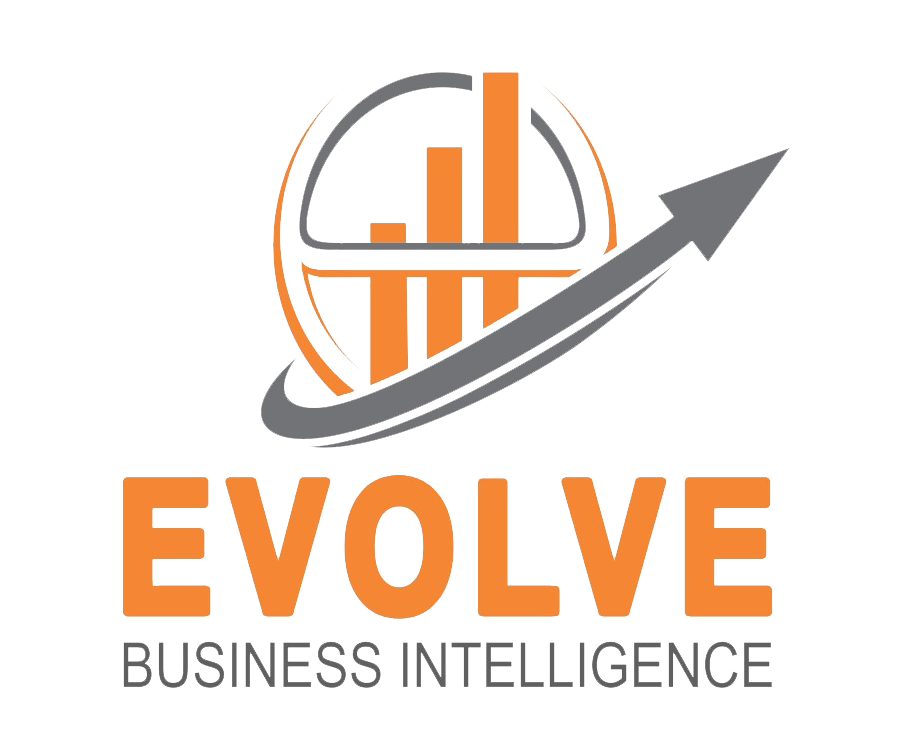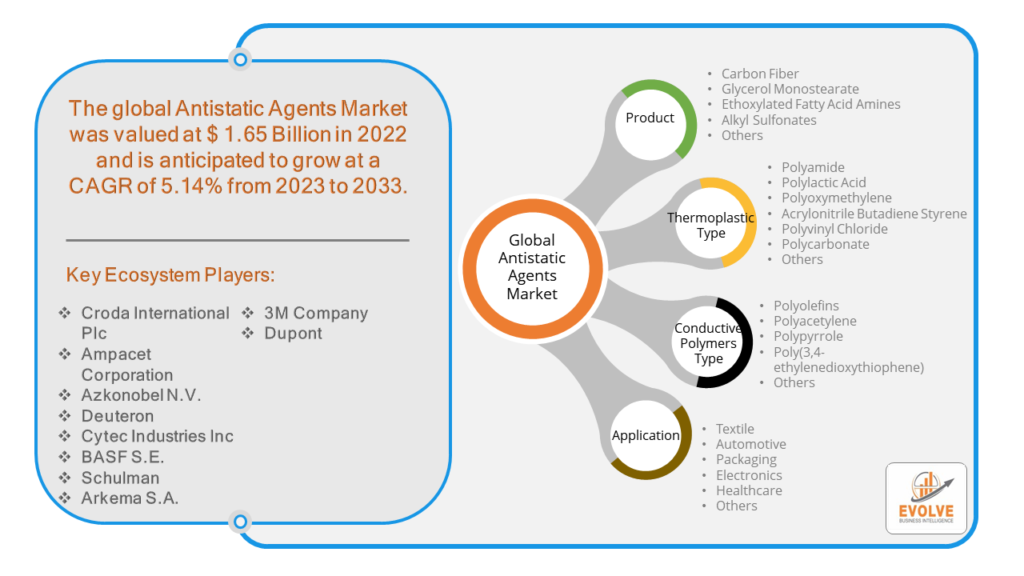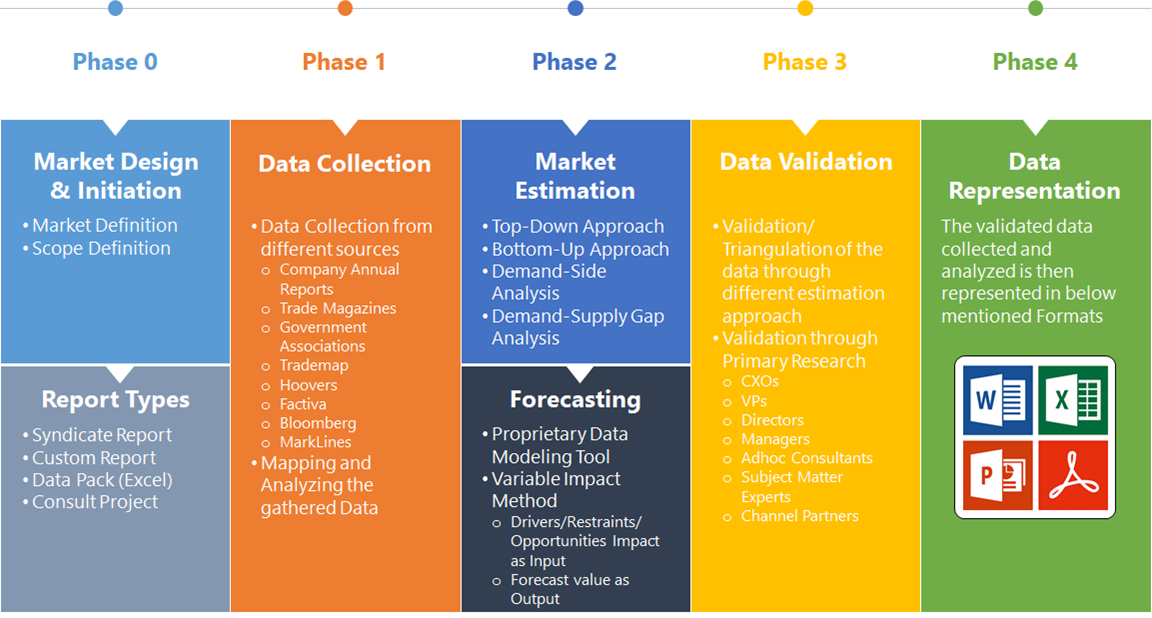Antistatic Agents Market Overview
Antistatic Agents Market Size is expected to reach USD 3.24 Billion by 2033. The Antistatic Agents industry size accounted for USD 1.65 Billion in 2023 and is expected to expand at a compound annual growth rate (CAGR) of 5.14% from 2023 to 2033. Chemical reagents known as antistatic agents are added to conductive polymers in order to boost volume conductivity and dielectric surface conductivity while also preventing static electricity. There are two types of antistatic agents: internal and exterior antistatic agents. While internal agents are mixed with the ingredients during the compounding stage, external agents are sprayed onto the surface. During the packaging, transit, and storage stages, handling issues arise due to the accumulation of static on plastic surfaces.By forming a layer on the surface, the antistatic agent additives lower the static force and shield the surface from the adhesion of undesired particles. By making the component conductive, antistatic chemicals reduce the possibility of static electricity and lower the risk of electrical shock for users.
Global Antistatic Agents Market Synopsis
The Antistatic Agents market experienced a detrimental effect due to the Covid-19 pandemic. The COVID-19 pandemic disrupted the construction chemicals market through supply chain interruptions, labor shortages, and project delays. Initial demand decline occurred due to halted construction activities, but the market began to recover as restrictions eased and construction projects resumed. The pandemic also accelerated the adoption of digital tools and technologies, enhancing efficiency and resilience in the construction sector.
Global Antistatic Agents Market Dynamics
The major factors that have impacted the growth of Antistatic Agents are as follows:
Drivers:
⮚ Increasing adoption of plastics in large scale applications
The increasing usage of plastics in various applications such as packaging is increasing the demand for the antistatic agents. The physical properties of plastics such as lightweight, corrosion resistance, chemically inert, durable, and recyclable has increased its application in various end-use industries including electronics and automotive. The manufacturers and consumers are shifting towards plastics from metal and wood. The electronics industry has adopted plastics as it is cost-effective and flexible.
Restraint:
- Technological Obsolescence
The rapid pace of technological advancements can render existing antistatic solutions obsolete. Continuous innovation is necessary to keep up with new materials and manufacturing technologies, which requires significant investment in research and development
Opportunity:
⮚ Technological Innovations
Advances in smart materials and nanotechnology offer the potential for developing high-performance antistatic agents. Innovations such as self-regulating static charges and enhanced compatibility with various materials can provide superior solutions for industries with stringent static control requirements, such as electronics and healthcare (MarkWide Research).
Antistatic Agents Market Segment Overview
By Product
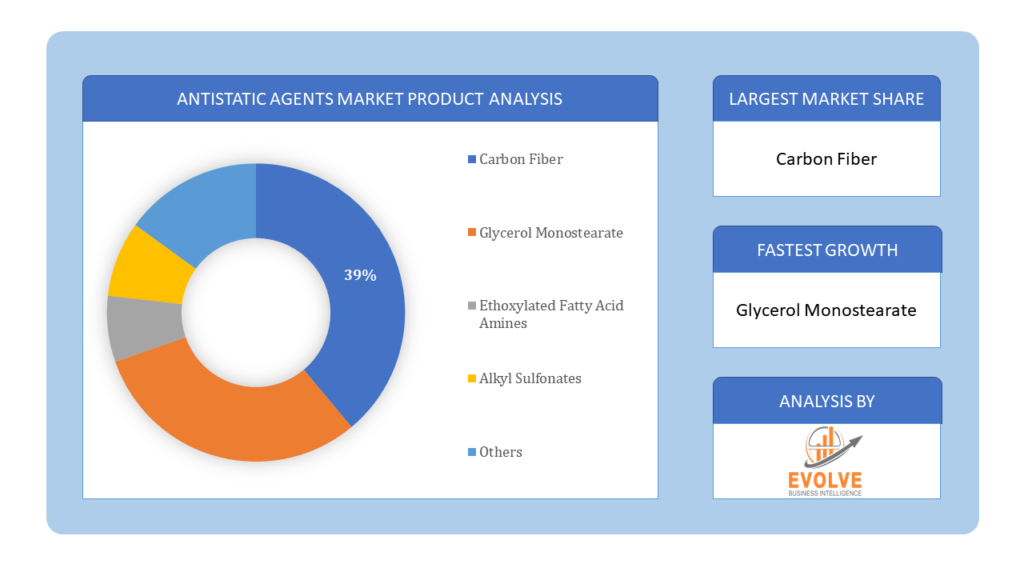 Based on the Product, the market is segmented based on Carbon Black, Carbon Fiber, Glycerol Monostearate, Ethoxylated Fatty Acid Amines, Alkyl Sulfonates, and Others. The antistatic agents market, segmented by product, sees significant dominance from Ethoxylated Fatty Acid Amines due to their effectiveness in reducing static charge in various polymers and their widespread use across multiple industries. Carbon Black and Glycerol Monostearate also hold substantial market shares, with Carbon Black being prominent in applications requiring enhanced conductivity and Glycerol Monostearate favored for its multifunctional properties.
Based on the Product, the market is segmented based on Carbon Black, Carbon Fiber, Glycerol Monostearate, Ethoxylated Fatty Acid Amines, Alkyl Sulfonates, and Others. The antistatic agents market, segmented by product, sees significant dominance from Ethoxylated Fatty Acid Amines due to their effectiveness in reducing static charge in various polymers and their widespread use across multiple industries. Carbon Black and Glycerol Monostearate also hold substantial market shares, with Carbon Black being prominent in applications requiring enhanced conductivity and Glycerol Monostearate favored for its multifunctional properties.
By Thermoplastic Type
Based on Thermoplastic Type, the market has been divided into Polyamide, Polylactic Acid, Polyoxymethylene, Acrylonitrile Butadiene Styrene, Polyvinyl Chloride, Polycarbonate and Others. In the antistatic agents market, the Polyvinyl Chloride (PVC) segment dominates due to its extensive use in electrical and electronic applications, where static control is critical. Polyamide also holds a significant share, driven by its application in the automotive and textile industries.
By Conductive Polymers Type
Based on the Conductive Polymers Type, the market has been divided into Polyolefins, Polyacetylene, Polypyrrole, Poly(3,4-ethylenedioxythiophene), and Others. In the antistatic agents market, the Polyolefins segment dominates due to their widespread use in packaging and automotive applications, where antistatic properties are crucial. Poly(3,4-ethylenedioxythiophene) (PEDOT) also holds a notable share for its high conductivity and stability in electronic applications.
By Application
Based on Application, the market has been divided into Textile, Automotive, Packaging, Electronics, Healthcare, and Others. In the antistatic agents market, the Packaging segment dominates due to the high demand for antistatic materials to protect sensitive electronic components during transportation and storage. The Electronics segment also holds a significant share, driven by the need for static control in the manufacturing and handling of electronic devices.
Global Antistatic Agents Market Regional Analysis
Based on region, the market has been divided into North America, Europe, Asia-Pacific, the Middle East & Africa, and Latin America. The area of Asia-Pacific is anticipated to dominate the market for the usage of Antistatic Agents, followed by those in North America and Europe.
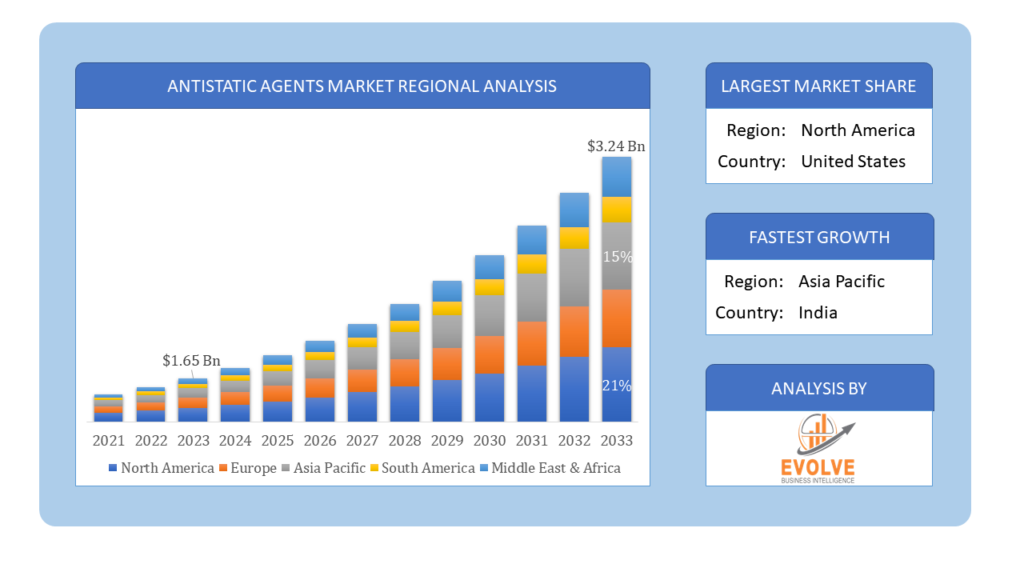 Antistatic Agents Asia-Pacific Market
Antistatic Agents Asia-Pacific Market
The Asia-Pacific region holds a dominant position in the Antistatic Agents market. Due to rising investments in the packaging sector and the rapidly expanding electronics, automotive, and textile sectors, the Asia Pacific region is expected to dominate the market. Due to the rising need for antistatic agents in the region’s automotive, electronics, military, and aerospace industries, North America is predicted to have profitable market expansion. Due to the large production and sales of automotive parts in numerous European nations, such as the UK, France, Germany, and Italy, Europe is expected to hold a sizable portion of the market.
Antistatic Agents North America Market
The North America region is witnessing rapid growth and emerging as a significant market for the Antistatic Agents industry. In terms of market share for anti-static agents, North America ranked second in 2017. This still holds true. This was and still is explained by the fact that, now that the economy is expanding at a reasonable rate, demand for cars is beginning to increase. The aerospace, defense, and electronics industries are strong in the North American region. In America, this is especially true. The need for plastics with anti-static compounds integrated into them is increasing as the US government and private businesses make greater investments in these fields.
Competitive Landscape
The competitive landscape includes key players (tier 1, tier 2, and local) having a presence across the globe. Companies such as Croda International Plc, Ampacet Corporation, Azkonobel N.V., Deuteron, and Cytec Industries Inc are some of the leading players in the global Antistatic Agents Industry. These players have adopted partnership, acquisition, expansion, and new product development, among others as their key strategies.
Key Market Players:
- Croda International Plc
- Ampacet Corporation
- Azkonobel N.V.
- Deuteron
- Cytec Industries Inc
- BASF S.E.
- Schulman
- Arkema S.A.
- 3M Company
- Dupont
Key Development:
In September 2017, Clariant announced a new amide/amine-free anti-static concentrate for clean-room and API films. This product is part of MEVOPUR, the brand of ‘Controlled, Consistent, and Compliant’ products for plastics applications in the medical and pharmaceutical industries.
Scope of the Report
Global Antistatic Agents Market, by Product
- Carbon Fiber
- Glycerol Monostearate
- Ethoxylated Fatty Acid Amines
- Alkyl Sulfonates
- Others
Global Antistatic Agents Market, by Thermoplastic Type
- Polyamide
- Polylactic Acid
- Polyoxymethylene
- Acrylonitrile Butadiene Styrene
- Polyvinyl Chloride
- Polycarbonate
- Others
Global Antistatic Agents Market, by Conductive Polymers Type
- Polyolefins
- Polyacetylene
- Polypyrrole
- Poly(3,4-ethylenedioxythiophene)
- Others
Global Antistatic Agents Market, by Application
- Textile
- Automotive
- Packaging
- Electronics
- Healthcare
- Others
Global Antistatic Agents Market, by Region
- North America
- US
- Canada
- Mexico
- Europe
- UK
- Germany
- France
- Italy
- Spain
- Benelux
- Nordic
- Rest of Europe
- Asia Pacific
- China
- Japan
- South Korea
- Indonesia
- Austalia
- Malaysia
- India
- Rest of Asia Pacific
- South America
- Brazil
- Argentina
- Rest of South America
- Middle East & Africa
- Saudi Arabia
- UAE
- Egypt
- South Africa
- Rest of Middle East & Africa
| Parameters | Indicators |
|---|---|
| Market Size | 2033: $3.24 Billion |
| CAGR | 5.14% CAGR (2023-2033) |
| Base year | 2022 |
| Forecast Period | 2023-2033 |
| Historical Data | 2021 |
| Report Coverage | Revenue Forecast, Competitive Landscape, Growth Factors, and Trends |
| Key Segmentations | Product, Thermoplastic Type, Conductive Polymers Type, Application |
| Geographies Covered | North America, Europe, Asia-Pacific, Latin America, Middle East, Africa |
| Key Vendors | Croda International Plc, Ampacet Corporation, Azkonobel N.V., Deuteron, Cytec Industries Inc, BASF S.E., Schulman, Arkema S.A., 3M Company, Dupont |
| Key Market Opportunities | Plastic is lightweight, corrosion resistance, chemically inert, durable, and recyclable, resulting in manufacturers and consumers preferring it over metal and wood |
| Key Market Drivers | The large-scale application of plastic in the packaging industry is a major driver for the growth of the antistatic agents market. |
REPORT CONTENT BRIEF:
- High-level analysis of the current and future Antistatic Agents Industry trends and opportunities
- Detailed analysis of current market drivers, restraining factors, and opportunities analysis in the future
- Historical market size for the year 2021, and forecast from 2023 to 2033
- Antistatic Agents market share analysis for each segment
- Competitor analysis with a comprehensive insight into its product segment, financial strength, and strategies adopted.
- Identifies key strategies adopted by the key players including new product development, mergers and acquisitions, joint ventures, collaborations, and partnerships.
- To identify and understand the various factors involved in the global Antistatic Agents market affected by the pandemic
- To provide year-on-year growth from 2022 to 2033
- To provide short-term, long-term, and overall CAGR comparison from 2022 to 2033.
- Provide Total Addressable Market (TAM) for the Global Antistatic Agents Market.
